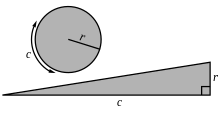Measurement of a Circle

Measurement of a Circle or Dimension of the Circle (Greek: Κύκλου μέτρησις, Kuklou metrēsis)[1] is a treatise that consists of three propositions by Archimedes, ca. 250 BCE.[2][3] The treatise is only a fraction of what was a longer work.[4][5]
Propositions
Proposition one

Proposition one states: The area of any circle is equal to a right-angled triangle in which one of the sides about the right angle is equal to the radius, and the other to the circumference of the circle. Any circle with a circumference c and a radius r is equal in area with a right triangle with the two legs being c and r. This proposition is proved by the method of exhaustion.[6]
Proposition two
Proposition two states:
The area of a circle is to the square on its diameter as 11 to 14.
This proposition could not have been placed by Archimedes, for it relies on the outcome of the third proposition.[6]
Proposition three
Proposition three states:
The ratio of the circumference of any circle to its diameter is greater than but less than .
This approximates what we now call the
Approximation to square roots
This proposition also contains accurate approximations to the square root of 3 (one larger and one smaller) and other larger non-perfect square roots; however, Archimedes gives no explanation as to how he found these numbers.[5]
He gives the upper and lower bounds to √3 as 1351/780 > √3 > 265/153.
References
- S2CID 119807724.
- ^ Lit, L.W.C. (Eric) van (13 November 2012). "Naṣīr al-Dīn al-Ṭūsī's Version of The Measurement of the Circle of Archimedes from his Revision of the Middle Books". Tarikh-e Elm.
The measurement of the circle was written by Archimedes (ca. 250 B.C.E.)
- ISBN 9780486675329.
Most accounts of Archimedes' works assign this writing to a time relatively late in his career. But this view is the consequence of a plain misunderstanding.
- ISBN 978-0-543-96877-7, retrieved 2008-06-30
- ^ a b "Archimedes". Encyclopædia Britannica. 2008. Retrieved 2008-06-30.
- ^ a b c Heath, Thomas Little (1897), The Works of Archimedes, Cambridge University: Cambridge University Press., pp. lxxvii , 50, retrieved 2008-06-30
- ISBN 978-0-486-43231-1
External links
- Measurement of a Circle, English translation by Thomas Heath



